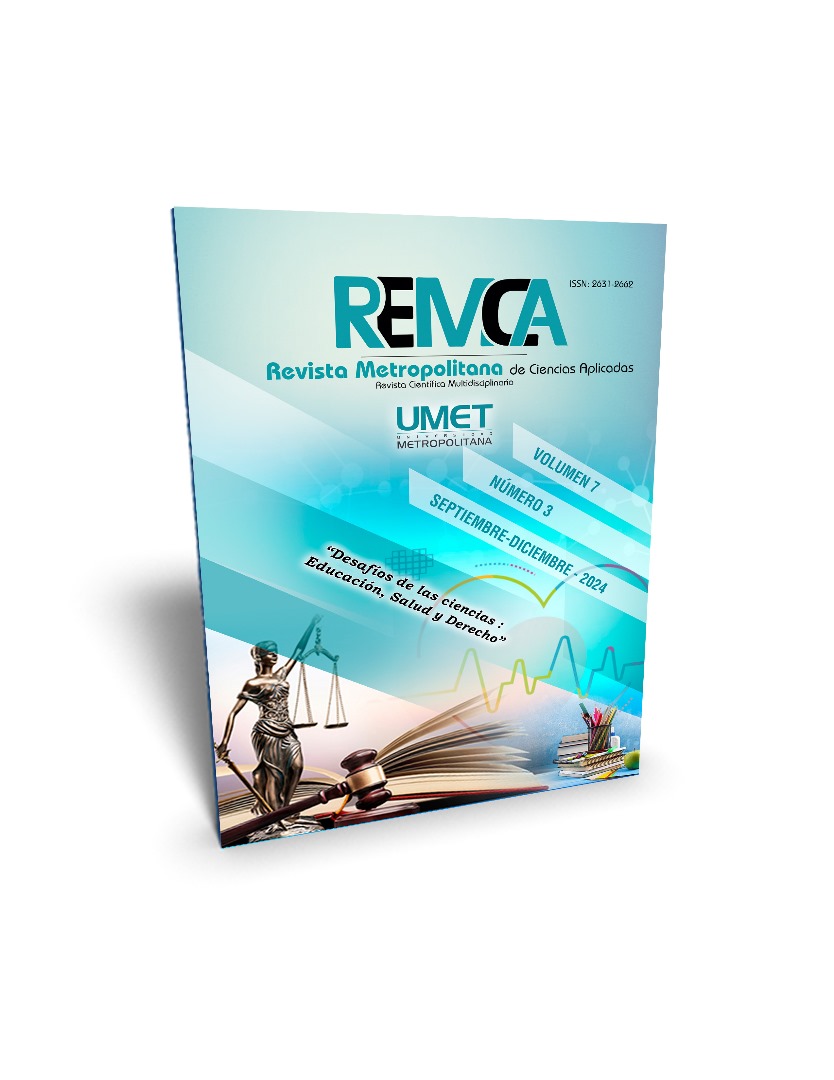Imposibilidad de presentar demanda reconvencional en materia de alimentos y el principio de economía procesal
DOI:
https://doi.org/10.62452/59cmb683Palabras clave:
Reconvención, procesos de alimentos, principios asociados a la reconvención, acumulación de pretensionesResumen
El Código Orgánico General de Procesos en Ecuador, que regula los procedimientos para la tramitación de los asuntos no penales, establece en su artículo 154 que la reconvención no procede en materia de alimentos, lo cual ha originado numerosos debates en la práctica acerca de la inconveniencia de que como resultado de su interpretación se tengan que promover varios procesos para solucionar asuntos relacionados con las medidas que se deben adoptar respecto a los hijos cuando el actor o la actora en el proceso solo reclama que se fije una pensión alimenticia. A partir de una profunda revisión bibliográfica y de la aplicación de métodos teóricos y jurídicos que sirvieron de base para el análisis e interpretación de la doctrina, la jurisprudencia y de la legislación nacional e internacional se asume la postura de considerar que en los procesos derivados de los derechos de los menores, en función de la tutela que debe ofrecer la jurisdicción familiar por la naturaleza del proceso y del interés superior del niño, los jueces deben dar solución a las medidas de alimentos, visitas, guarda y cuidado que se deriven del proceso sin que sea exigible la reconvención, siempre que la decisión no implique la sorpresa o indefensión para el demandante o el demandado.
Descargas
Referencias
Cano, O. (2024a). El Especial Tratamiento de la Reconvención en los Procesos de Familia. https://www.oscar-cano.com/el-especial-tratamiento-de-la-reconvencion-en-los-procesos-de-familia/
Cano, O. (2024b). La Reconvención en los Procesos de Familia. https://www.oscar-cano.com/la-reconvencion-en-los-procesos-de-familia/
Echandía, D. (2013). Teoría General del Proceso. Universidad .
Ecuador. Asamblea Nacional Constituyente. (2008). Constitución de la República del Ecuador. Registro Oficial No. 449. https://www.oas.org/juridico/pdfs/mesicic4_ecu_const.PDF
Ecuador. Asamblea Nacional. (2009). Código Orgánico de la Función Judicial. Registro Oficial Suplemento 544. https://www.registroficial.gob.ec/index.php/registro-oficial-web/publicaciones/suplementos/item/4134-suplemento-al-registro-oficial-no-544
Ecuador. Asamblea Nacional. (2015). Código Orgánico General de Procesos. Registro Oficial Suplemento 506. https://www.ces.gob.ec/lotaip/2021/Marzo/a2/C%C3%B3digo%20Org%C3%A1nico%20General%20de%20Procesos,%20COGEP.pdf
Ecuador. Congreso Nacional. (2003). Código Orgánico de la Niñez y de la Adolescencia. Registro Oficial 737. https://www.igualdad.gob.ec/wp-content/uploads/downloads/2019/12/codigo_ninez_adolescencia_nov2019.pdf
Ecuador. Corte Nacional de Justicia. (2018). Resolución 04-2018. https://www.cortenacional.gob.ec/cnj/images/pdf/resoluciones/2018/18-04%20Fijacion%20de%20alimentos.pdf
Ecuador. Corte Nacional de Justicia. (2020). Absolución de Consultas. Criterio no Vinculante. https://www.cortenacional.gob.ec/cnj/images/pdf/consultas_absueltas/No_Penales/Procesal/188.pdf
Estados Unidos Mexicanos. Suprema Corte de Justicia de la Nación. (2011). Juicios Sumarios de Desocupación en el Código de Procedimientos Civiles del Estado de Jalisco. No está previsto el derecho a reconvenir. https://sjf2.scjn.gob.mx/detalle/ejecutoria/23108
Ilich Ignacio, L. (2021). Contestacion de Alimentos con Reconvencional. Chandia Muñoz. https://es.scribd.com/document/510590264/contestacion-de-alimentos-con-reconvencional-CHANDIA-MUNOZ-1
López Ochoa, M. (2023). Naturaleza Jurídica de La Reconvención. Novedades Jurídicas, (199), 6-18. https://edicioneslegales.com.ec/wp-content/uploads/2023/01/REVISTA-NJ199.pdf
Mendoza Medina, J. G., Bravo Castro, H., Falcones Ferrin, I. A., Buenaventura Navas, J. C., & Macías Párraga, J. O. (2017). Caso Civil que sigue Palma Palma Delly Beatriz contra Palma Palma José Virgilio: “Vulneración al derecho a la garantía básica del debido proceso en la sentencia dictada dentro la causa 13204-2014-4454”. (Trabajo de titulación). Universidad de San Gregorio de Portoviejo.
Montero Aroca, J., & Chacón Dorado, M. (2019). Manual de Derecho Procesal Civil. Tirant lo Blanch.
Morán Sarmiento, R. ( 2011). Derecho Procesal civil práctico. VLEX.
Morán Sarmiento, R. (2003). Derecho Procesal Civil. Publisher.
Navarro & La Rosa Abogados. (2015). ¿Es necesaria la reconvención para la modificación de la pensión alimentos? http://nlrabogadosalicante.com/divorcio-reconvencion-modificacion-pension-alimentos/
Palomo Vélez, D. (2008). La Oralidad en el Proceso Civil: El Nuevo Modelo Español. Librotecnia.
Quisbert, E. (2010). Apuntes de derecho procesal civil boliviano. USFX.
Rendón Garnica, V. (2016). Reconvención en demanda de alimentos para menor de tres años. https://www.youtube.com/watch?v=vZIob3HOzdk
Descargas
Publicado
Número
Sección
Licencia
Derechos de autor 2024 Arianna Elizabeth Agila-Tibillin, Gabriela Alexandra Agila-Tibillin, Armando Rogelio Duran-Campo (Autor/a)

Esta obra está bajo una licencia internacional Creative Commons Atribución-NoComercial-CompartirIgual 4.0.
Los autores que publican en la Revista Metropolitana de Ciencias Aplicadas (REMCA), están de acuerdo con los siguientes términos:
1. Derechos de Autor
Los autores conservan los derechos de autor sobre sus trabajos sin restricciones. Los autores otorgan a la revista el derecho de primera publicación. Para ello, ceden a la revista, de forma no exclusiva, los derechos de explotación (reproducción, distribución, comunicación pública y transformación). Los autores pueden establecer otros acuerdos adicionales para la distribución no exclusiva de la versión de la obra publicada en la revista, siempre que exista un reconocimiento de su publicación inicial en esta revista.
© Los autores.
2. Licencia
Los trabajos se publican en la revista bajo la licencia de Atribución-NoComercial-CompartirIgual 4.0 Internacional de Creative Commons (CC BY-NC-SA 4.0). Los términos se pueden consultar en: https://creativecommons.org/licenses/by-nc-sa/4.0/deed.es
Esta licencia permite:
- Compartir: copiar y redistribuir el material en cualquier medio o formato.
- Adaptar: remezclar, transformar y crear a partir del material.
Bajo los siguientes términos:
- Atribución: ha de reconocer la autoría de manera apropiada, proporcionar un enlace a la licencia e indicar si se ha hecho algún cambio. Puede hacerlo de cualquier manera razonable, pero no de forma tal que sugiera que el licenciador le da soporte o patrocina el uso que se hace.
- NoComercial: no puede utilizar el material para finalidades comerciales.
- CompartirIgual: si remezcla, transforma o crea a partir del material, debe difundir su creación con la misma licencia que la obra original.
No hay restricciones adicionales. No puede aplicar términos legales ni medidas tecnológicas que restrinjan legalmente a otros hacer cualquier cosa que la licencia permita.




